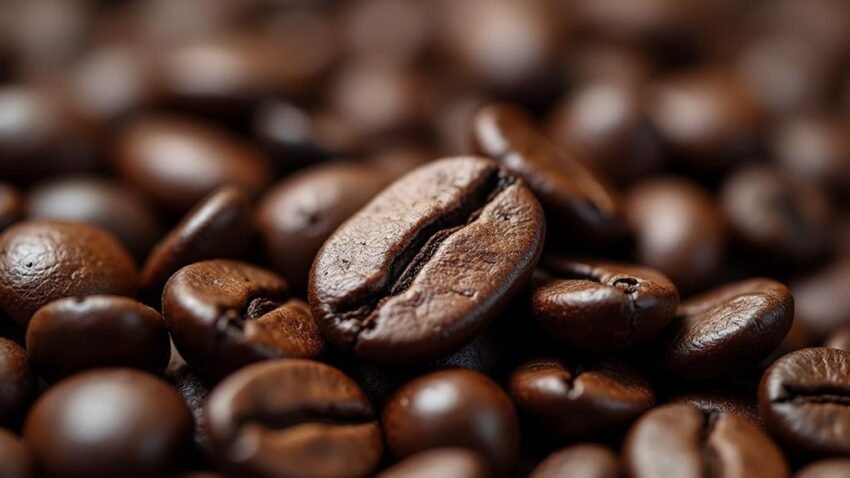For those who crave a coffee that's as bold as it is mysterious, French Roast is the go-to choice. This dark roasting method, which isn't actually from France but rather a technique that originated in 19th-century Europe, transforms beans into a smoky, full-bodied brew with low acidity. The process involves high-temperature roasting that caramelizes natural sugars, resulting in hints of chocolate and roasted nuts. But what makes French Roast truly special? Let's uncover the secrets behind its rich flavor profile and discover why it remains a staple in global coffee culture.
What Is French Roast Coffee?
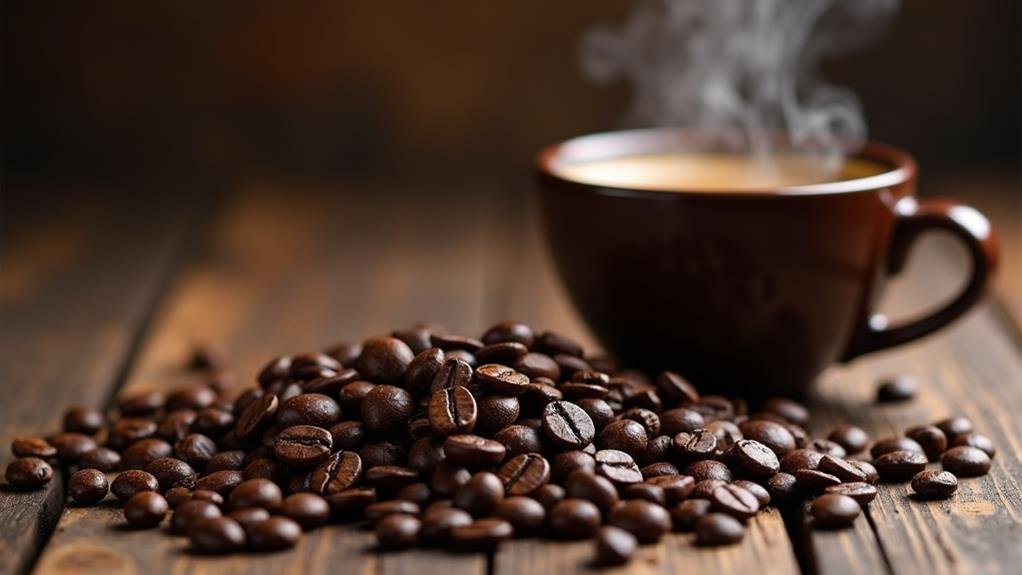
French Roast Coffee is a specific type of dark roast known for its intense, smoky flavor profile. It stands out from other coffee types due to the high temperatures used in the roasting process, which transforms the beans into very dark brown specimens with a light oil sheen. This roasting process not only darkens the beans but also caramelizes their natural sugars, resulting in a bold taste that hints at chocolate, smoke, and roasted nuts.
One of the defining characteristics of French Roast Coffee is its low acidity compared to lighter roasts. This makes it a popular choice for those who prefer a full-bodied brew without the sharpness often found in less roasted coffees.
The roasting process for French Roast Coffee is so intense that it masks regional characteristics of the beans, meaning that whether you're using beans from Ethiopia or Brazil, the final flavor profile will be primarily influenced by the roast.
Origin of French Roast
Understanding the origin of French Roast Coffee takes us back to 19th-century Europe. Although the name suggests a direct connection to France, it's crucial to mention that the term "French Roast" actually refers to a roasting method rather than its country of origin. This style of coffee roasting emerged in the 1800s and has since become a staple in coffee culture.
The French Roast method involves roasting beans to a darker level, which results in a distinct flavor profile characterized by smoky and slightly sweet notes. This roasting technique has been adopted by roasters worldwide, each with their own interpretation of what constitutes a true French Roast. Despite these variations, the core principle remains the same: achieving a deep roast that brings out a robust flavor style.
The global adoption of this method underscores its popularity and versatility. Whether you're in Europe, the Americas, or Asia, you can find coffee shops and roasters who specialize in French Roast. The name itself implies a specific flavor style rather than any direct French origin, making it evident that this method is about the craft of roasting rather than geographical heritage.
French Roast Flavor Profile
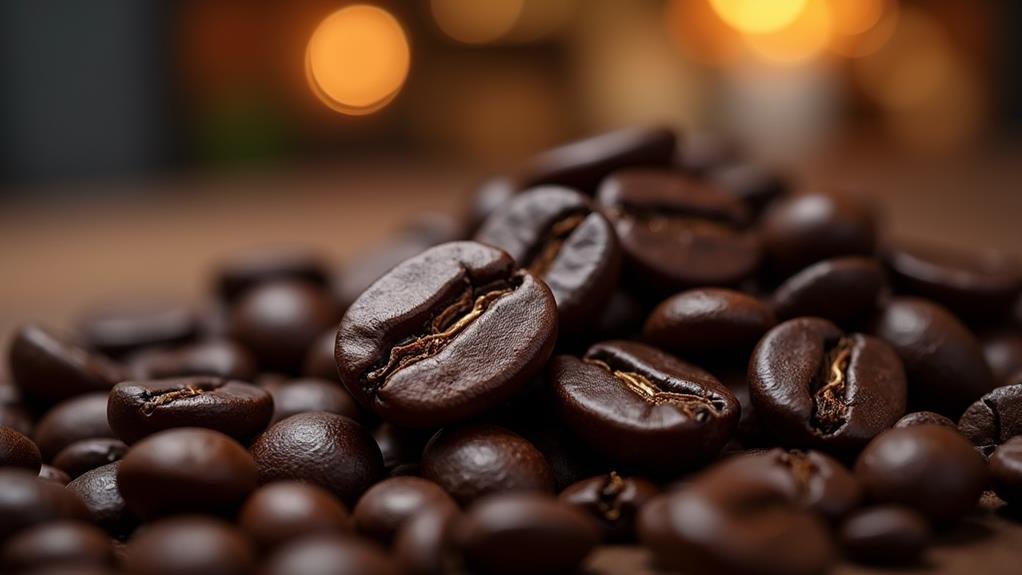
When I sip French roast coffee, I'm immediately hit with smoky and caramel notes that stand out in its flavor profile.
This coffee offers a rich and full-bodied taste, which is a result of the extended roasting time and high temperature used in its production.
The hints of chocolate and roasted nuts add depth to the experience, making each cup uniquely satisfying.
Smoky and Caramel Notes
Deep within the flavor profile of French roast coffee lies a rich tapestry of smoky and caramel notes. When you sip a French roast, you're immediately greeted by its smoky flavor, which is a result of the intense roasting process. This smokiness is balanced by caramel notes that add a layer of sweetness and depth to the coffee.
The smoky flavor in French roast coffee comes from the high temperatures used during the roasting process. This method caramelizes the natural sugars in the beans, creating hints of dark chocolate and caramel that complement the smokiness perfectly.
Unlike lighter roasts, French roast coffee has low acidity, allowing the full-bodied, intense flavor profile to take center stage.
The combination of these smoky and caramel notes highlights the skill of roasters in creating a coffee experience with deep, complex flavors. Each sip reveals a harmony of rich, bold tastes that are both satisfying and refined.
Whether you're a coffee aficionado or just discovering French roast, the smoky and caramel notes are sure to delight your palate and appreciate the artistry involved in crafting such a distinct coffee.
Rich and Full-Bodied Taste
French roast coffee delivers a rich and full-bodied taste that's hard to miss. This bold flavor profile is a result of the extended roasting time and high temperatures used in the roasting process. When you take a sip of French roast coffee, you're greeted by a deep, caramelized taste that's both intense and satisfying.
One of the key aspects of French roast coffee's full-bodied taste is its complex tasting notes. Here are three reasons why it stands out:
- Deep Chocolate Notes: The caramelized flavor often brings out hints of dark chocolate, adding a richness to the coffee.
- Smoky Undertones: The high-temperature roasting process introduces smoky elements that enhance the depth of the coffee.
- Roasted Nut Accents: You might also notice subtle hints of roasted nuts, which contribute to the full-bodied experience.
These tasting notes combine to create a coffee that's perfect for those who enjoy intense flavors. The origin of the beans also plays a role in shaping these nuances, making each cup unique.
Roasting Process
The roasting process for French roast coffee is a precise and careful step that sets it apart from other coffee roasts. This roasting style involves subjecting the coffee beans to extremely high temperatures, typically between 450 and 455 degrees Fahrenheit. Unlike lighter roasts, French roast beans undergo an extended roasting time, which greatly impacts their flavor profile.
During this process, the beans transform into dark brown coffee beans with a light oil sheen. The extended roasting time and high temperatures are vital factors that contribute to the bold taste of French roast coffee. These darker roasts are achieved by allowing the beans to roast for a longer period than other roast profiles, enhancing their robust and full-bodied flavor.
After reaching the desired roast level, the French roast beans are quickly cooled to preserve their flavor. This careful cooling guarantees that the coffee retains its distinctive taste and aroma.
Once cooled, these beans can be ground or packaged whole for brewing, ready to deliver that rich and full-bodied taste that French roast is known for. The careful attention to detail in the roasting process is what makes French roast coffee so unique and appealing to coffee lovers.
Health Benefits
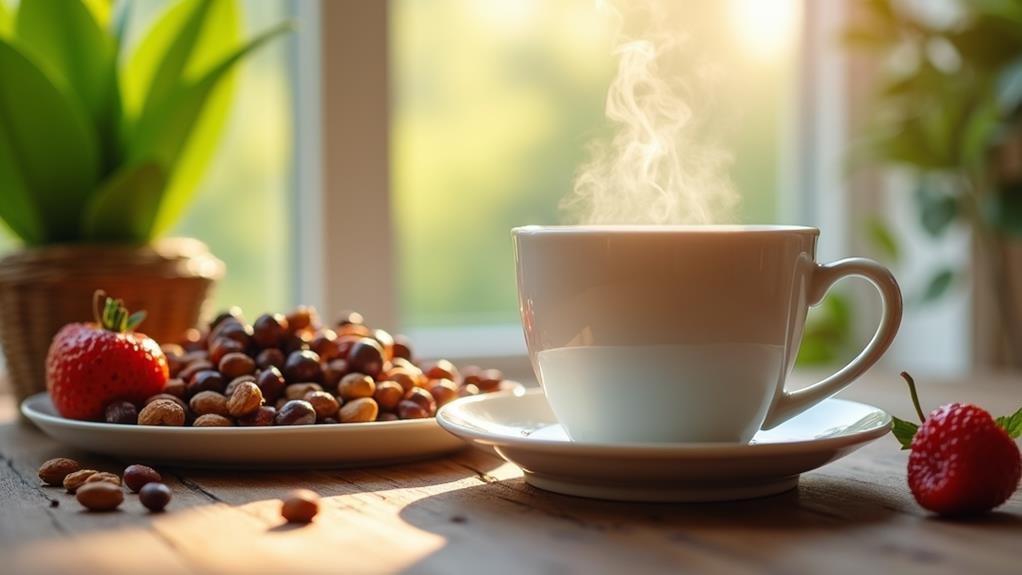
After understanding the meticulous roasting process that defines French roast coffee, it's worth exploring its health benefits. Like all coffee roasts, French roast contains antioxidants, which are essential for overall health and well-being. Here are some key health benefits associated with French roast coffee:
- Reduced Risk of Chronic Diseases: Drinking French roast coffee can help lower the risks of heart failure and diabetes.
- Neuroprotective Effects: It may also reduce the risks of Parkinson's and Alzheimer's diseases.
- Stomach Health: French roast is less acidic than lighter roasts, making it gentler on the stomach and reducing the likelihood of acid reflux.
Additionally, while French roast coffee has a bold flavor, it contains slightly less caffeine than lighter roasts. This offers a smoother but still robust coffee experience.
It's important to remember that individual reactions to coffee can vary, so it's always best to consult a physician for personalized health advice regarding coffee consumption and its effects on individual health conditions. Overall, French roast coffee not only provides a rich and satisfying taste but also offers several health benefits that make it a good choice for coffee lovers.
Caffeine Content
When it comes to my daily cup of coffee, I often wonder about the caffeine content of French roast. If you're like me and curious about how much caffeine is in your French roast coffee beans, here's what you need to know: French roast coffee generally has lower caffeine levels compared to lighter roasts.
The intense roasting process of French roast beans is a key factor in reducing their caffeine content. This process, which involves roasting the beans to a darker shade, not only changes the flavor profile but also affects the amount of caffeine retained. As a result, dark roast coffee beans, including French roast, are known for their bold flavor rather than high caffeine content.
If you're seeking a strong caffeine kick, opting for light roast coffee over French roast might be your best bet. Light roast coffee typically retains more of its original caffeine because it's roasted for a shorter time. This makes it a better choice if you're looking for an energy boost from your morning cup.
However, if you prefer the rich, bold flavor that dark roasts offer, French roast remains a great option—just be aware of its lower caffeine content.
Brewing Methods
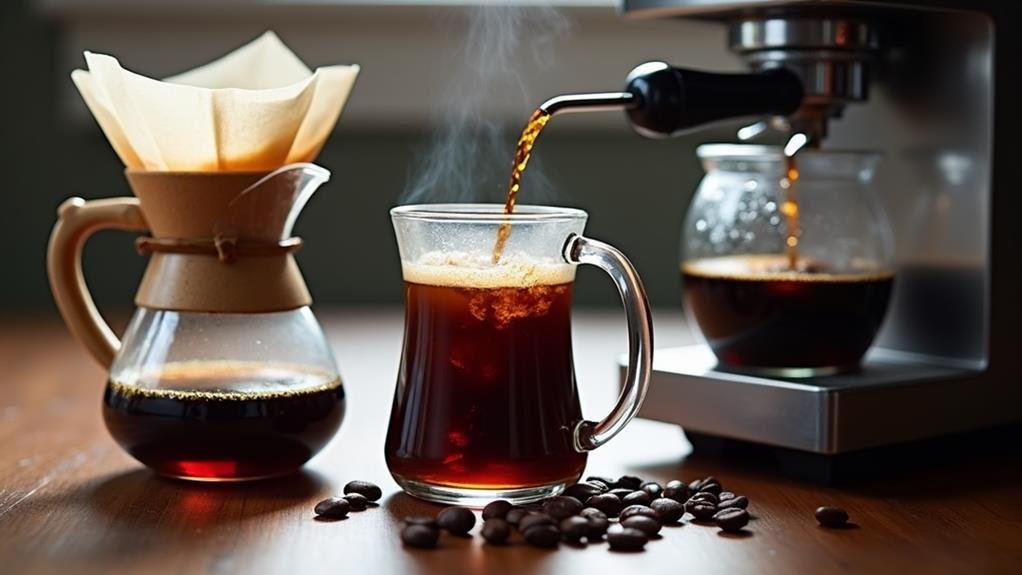
When it comes to brewing French roast coffee, I prefer methods that bring out its rich, bold flavors.
Drip brewing is a great way to start, as it allows for a balanced extraction of the coffee's smoky and caramelized notes.
For an even more intense experience, I turn to espresso and French press, which preserve the full-bodied characteristics of French roast coffee.
Drip Brewing Techniques
Drip brewing is a go-to method for many French roast coffee enthusiasts, and for good reason. When it comes to brewing French roast coffee, this technique offers several advantages that make it a popular choice.
First and foremost, drip brewing involves pouring hot water over ground coffee in a filter. The water then drips through the coffee grounds into a carafe or pot below. This simple process allows for a consistent extraction of the rich flavors inherent in French roast coffee.
Here are three key reasons why drip brewing works so well for French roast:
- Consistent Flavor: Drip brewing ensures that the water flows evenly through the coffee, resulting in a uniform extraction every time.
- Highlighting Rich Flavors: This method allows the bold, smoky notes of French roast to stand out without diluting them.
- Ease of Use: Drip brewers are relatively easy to operate, making it accessible for anyone looking to brew high-quality coffee at home.
Espresso and French Press
French roast coffee, with its intense flavors and deep notes, lends itself perfectly to both espresso and French press brewing methods. When it comes to making espresso, French roast coffee is a top choice because of its bold and rich taste. The intense flavors of French roast are well-suited for espresso preparation, allowing the coffee's unique characteristics to shine through in the final cup.
In contrast, the French press brewing method enhances the smoky and caramelized notes of French roast coffee. This brewing technique results in a full-bodied brew that showcases the coffee's deep, smoky undertones.
Both espresso and French press methods allow the distinct flavors of French roast to be fully appreciated, making it a versatile coffee that can be enjoyed in multiple ways.
Whether you prefer the concentrated, bold shot of an espresso or the richer, more nuanced flavor of a French press, French roast coffee adapts beautifully to either brewing method. This versatility is part of what makes French roast such a beloved choice among coffee enthusiasts. Each brewing method highlights different aspects of the coffee, ensuring that every cup is a delightful experience.
Shelf Life and Freshness
Coffee enthusiasts often find themselves pondering the shelf life of their favorite brews, especially when it comes to French roast coffee. While French roast beans are known for their rich, bold flavor profile, they do come with some specific considerations regarding freshness and shelf life.
One key factor is the presence of oils on the surface of French roast beans. These oils can promote bacteria growth, potentially reducing the longevity of these beans compared to other roasts. However, this difference in shelf life is minimal.
To keep your French roast beans fresh for as long as possible:
- Store them in a sealed, airtight container: This prevents air and moisture from impacting the beans.
- Keep them in the fridge: If you plan to store them for an extended period, like up to a year.
- Use proper storage immediately after opening: Even if you won't be using them for a while, proper storage helps maintain freshness.
Both French roast and dark roast beans will generally stay fresh for at least a week when stored correctly. While French roast may require a bit more care due to their oilier nature, following these simple steps can guarantee you enjoy your coffee at its best.
Comparison to Other Roasts
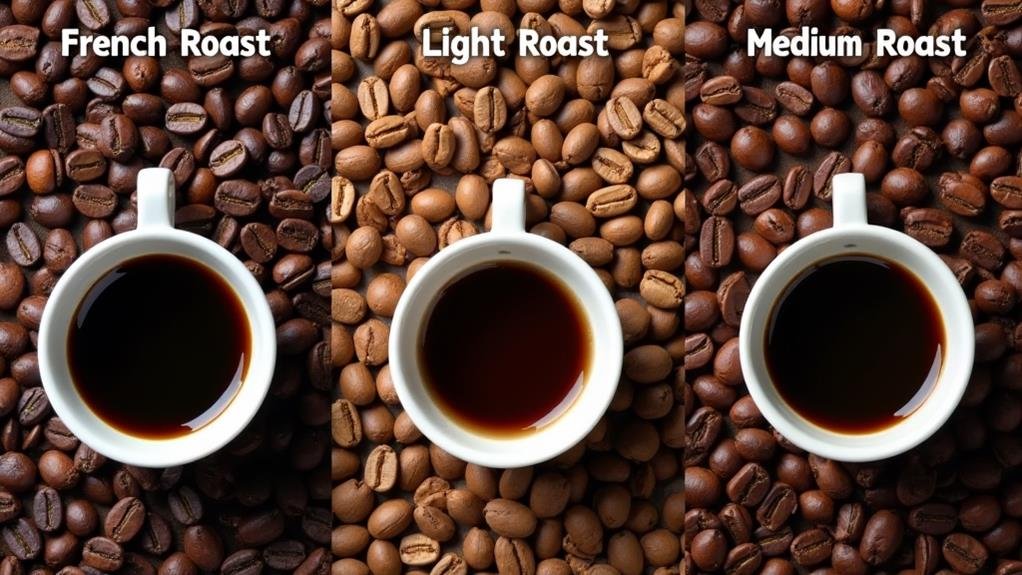
To sum up, French roast differentiates itself from other roasts with its distinct flavor profile. French roast offers a sweeter and smokier taste, along with a caramelized flavor that sets it apart from lighter roasts. This distinct taste stems from the longer, hotter roasting process that prioritizes roaster-induced flavors over the inherent characteristics of the coffee beans.
In contrast to lighter roasts that accentuate the natural flavors of the beans, French roast undergoes a chemical reaction during its prolonged roasting period. This not only amplifies the flavor but also diminishes the acidity, resulting in a less acidic and more intense overall taste in French roast coffee. This unique combination of attributes makes French roast suitable for various brewing techniques, as it retains its robust flavor regardless of the method used.
Another notable difference lies in the caffeine content. Due to its extended roasting process, French roast coffee contains lower caffeine levels compared to lighter roasts. This can be advantageous for individuals seeking a richer coffee experience without the high caffeine content.
To conclude, French roast stands out for its exceptional blend of sweetness, smokiness, and caramelized flavor, appealing to coffee aficionados who enjoy a deeper, less acidic flavor profile.
Preparing French Roast at Home
To prepare French roast coffee at home, I focus on mastering important brewing techniques and investing in the right equipment. Controlling water temperature, grind size, and brewing time is essential for bringing out the unique flavors and aroma of French roast beans. Whether I'm using a French press, pour-over, espresso machine, or drip coffee maker, having quality tools enhances my brewing experience greatly.
Brewing Techniques
Brewing French roast coffee at home can be as simple as adjusting a few key elements to bring out its full-bodied and intense flavor. The choice of brewing method is vital, as different techniques can highlight various aspects of French roast's rich and smoky profile.
For a classic experience, methods like French press, espresso, or drip coffee are ideal. Here are three key methods to ponder:
- French Press: This method immerses the coffee grounds in hot water, which helps to extract the deep, smoky notes.
- Espresso: A concentrated shot that brings out the intense and bold characteristics of French roast.
- Drip Coffee: A simple and convenient method that allows for a balanced extraction of flavors.
To enhance the brewing process, adjust the grind size and water temperature. A finer grind with hotter water can bring out the caramel notes, while a coarser grind with slightly cooler water may emphasize the smoky flavors.
Experimenting with different brewing techniques, such as using a Moka pot or AeroPress, can also help you find the perfect balance of intensity and smoothness in your French roast coffee. By fine-tuning these factors, you can uncover the full potential of your French roast beans at home.
Equipment Essentials
What equipment do you need to bring out the full-bodied flavor of French roast coffee at home? To start, a quality burr grinder is essential for achieving a consistent grind size. This consistency is important because it ensures that each bean extracts evenly, contributing to a balanced flavor profile.
A scale is also necessary for measuring coffee grounds accurately. Without precise measurements, the flavor can become unbalanced or irregular.
Investing in a French press or espresso machine can greatly enhance your brewing experience for French roast coffee. These devices allow for ideal extraction and bring out the rich, smoky notes characteristic of French roast.
Additionally, a gooseneck kettle is useful for precise water pouring, which helps in achieving proper extraction during brewing.
Conclusion
French Roast coffee is like a masterfully conducted symphony—each note of smoky flavor and chocolate undertones harmonizes to create a rich, full-bodied experience. Just as a conductor brings together diverse instruments, French Roast combines caramelized sugars and roasted nuts to mask regional bean characteristics. This perfect blend makes it a staple in coffee culture, appealing to those seeking an intense and satisfying brew. Whether you're a coffee aficionado or just discovering dark roasts, French Roast is sure to resonate with you.

